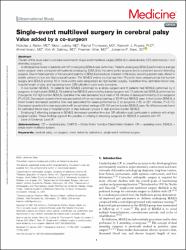Single-event multilevel surgery in cerebral palsy Value added by a co-surgeon

Göster/
Tarih
2021Yazar
J. Nahm, NickolasLudwig, Meryl
Thompson, Rachel
Rogers, Kenneth J.
İmerci, Ahmet
Dabney, Kirk W.
Miller, Freeman
Sees, Julieanne P.
Üst veri
Tüm öğe kaydını gösterKünye
Nahm, Nickolas J. MDa; Ludwig, Meryl MDb; Thompson, Rachel MDc; Rogers, Kenneth J. PhDd; Imerci, Ahmet MDe; Dabney, Kirk W. MDd; Miller, Freeman MDd,∗; Sees, Julieanne P. DOf Single-event multilevel surgery in cerebral palsy, Medicine: June 18, 2021 - Volume 100 - Issue 24 - p e26294 doi: 10.1097/MD.0000000000026294Özet
The aim of this study was to compare outcomes for single-event multilevel surgery (SEMLS) in cerebral palsy (CP) performed by 1 or 2 attending surgeons. A retrospective review of patients with CP undergoing SEMLS was performed. Patients undergoing SEMLS performed by a single senior surgeon were compared with patients undergoing SEMLS by the same senior surgeon and a consistent second attending surgeon. Due to heterogeneity of the type and quantity of SEMLS procedures included in this study, a scoring system was utilized to stratify patients to low and high surgical burden. The SEMLS events scoring less than 18 points were categorized as low burden surgery and SEMLS scoring 18 or more points were categorized as high burden surgery. Operative time, estimated blood loss, hospital length of stay, and operating room (OR) utilization costs were compared. In low burden SEMLS, 10 patients had SEMLS performed by a single surgeon and 8 patients had SEMLS performed by 2 surgeons. In high burden SEMLS, 10 patients had SEMLS performed by a single surgeon and 12 patients had SEMLS performed by 2 surgeons. For high burden SEMLS, operative time was decreased by a mean of 69 minutes in cases performed by 2 co-surgeons (P=0.03). Decreased operative time was associated with an estimated savings of $2484 per SEMLS case. In low burden SEMLS, a trend toward decreased operative time was associated for cases performed by 2 co-surgeons (182 vs 221 minutes, P=0.11). Decreased operative time was associated with an estimated savings of $1404 per low burden SEMLS case. No difference was found for estimated blood loss or hospital length of stay between groups in high and low burden SEMLS. Employing 2 attending surgeons in SEMLS decreased operative time and OR utilization cost, particularly in patients with a high surgical burden. These findings support the practice of utilizing 2 attending surgeons for SEMLS in patients with CP. Level of Evidence: Level III

















